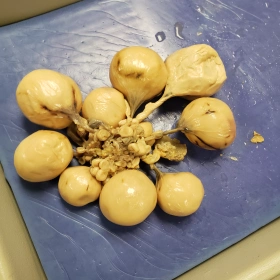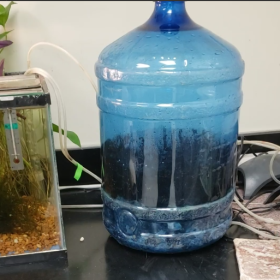
Could it be possible that the sperm/particles which fertilized the egg is/are MOSTLY from the babies’ daddy?
Darwin (1884) on pages 370-375 in volume II of his second edition of “The Variation of Animals and Plants under Domestication” implied that the “male element” with its accompanying gemmules can “act on the female tissue and influence future progeny.” This effect is anticipated before direct fertilization. The idea of telegony in heredity is this very essence: that male sperm in the body of the female (or pollen in the case of a plant), prior to fertilization can influence the genetics of the actual fertilized ovum.
Gemmules were the proposed particles of the Pangenesis hypothesis of Darwin as described in his book: “Animals and Plants under Domestication,” in Chapter 27 of his 2nd edition, Vol. 2. Current proposed particle identities have been suggested by Liu (2008). Please download the full research article and not simply the abstract to get the full scope of the possible potential particles which might act as Darwin’s “gemmules.”
Your thoughts?
Other resources (deepen your understanding of the topic):
Epigenetics: Overkalix study findings
Reflections and additional content below:
“Baby Daddy blog” reflection on 2-8-2019: ( I am now officially referring to this blog as the “Baby Daddy blog.”)
I have been thinking over the past few days about Darwin’s gemmules from his Pangenesis theory and how he suggested that they could reproduce and lodge in the female reproductive (ovaries). In my mind, I have to remember that Darwin was describing things and phenomena which had not been properly named (or at least had not acquired a universally accepted name). In my mind, the best match I can imagine is some particle that acts like a virus. So for now, I am suggesting that the identity of his gemmule happened to be a virus. At this point, I do not know enough about prions to introduce them into the discussion.
So if these gemmules were introduced by prior partners of a woman before her fertilization, a virus could be described as this “gemmule” thing that could reproduce at once in her body and then “lodge” or genetically modify her genome. Sounds like a virus.
Next thought; rather a dark one. Could the gemmules Darwin was speaking of be viruses which could efficiently be “vectored” into the woman via a sexually transmitted infection, such as human papillomavirus? What better than a highly infectious agent to introduce and change the genome?
Next question is how much does it change the woman’s genome? It is enough to contribute to different traits in the baby created by a later fertilizing “baby daddy?”
My understanding is that when an infectious virus replicates in the body of the donor, it takes on some of the cell membrane and possibly hijacks DNA from the host (via genetic linkage?); maybe little pieces that could then be inserted into the recipient DNA. So, if my thinking is correct, any virus we receive could in fact contribute to the amount of junk DNA within our own DNA.
To me, junk DNA from a virus (oncovirus) can form an oncogene that could lead to cancer. In my mind, all of this begins to rationalize the practice of retaining one faithful reproductive partner for a lifetime with the side benefit of having less junked-up DNA which could be passed on to the babies.
This also brings me back to one of my original questions in this reflection: If junk DNA from a “giver” of the virus is possibly spliced along with the viral DNA, would it, could it ever be enough in quantity to actually influence a trait of the baby created by a later fertilization to the point that it would resemble traits produced by DNA from a prior “donor” which did not result in fertilization at that time?
OK, geneticists and infectious disease experts, I need your collaboration. Are any of the ideas in this reflection plausible? Thank you in advance for your consideration.
7/2/2020 Reflection
Considering the highly infective nature of the COVID-19 virus, could “relations” with an infected individual serve as an ” RNA transmission moment?”
The corona wiki article indicated that genetic recombination can occur when more that one “viral genome” is present.
3/9/2023 update
In response to discussion with a colleague today, I searched for “epigenetic influence and fertilization” today and this article popped up immediately:
Sperm epigenetics and influence of environmental factors
If one moves to “Concluding remarks,” in the paper cited above, the indication is that seminal fluid can affect the fetal environment at the time of fertilization, specifically hormone levels. Later in the Concluding remarks, the observation is also made that epigenetic influence on the sperm can occur while in while in the female genital tract.
The question by me in this case would be that if the semen from one male was mixed with semen from another male within the female genital tract, could the sperm from one male then be affected and influenced by semen from the other?









I personally find it hard to believe that DNA from a previous male could influence the genetics of a future child with a different male. There are certain things that seem to be acting in a similar way such as epigenetics, and while interesting, they still function via direct parent to offspring inheritance. Here’s a cool video on the subject https://youtu.be/AvB0q3mg4sQ. While epigenetics does not work by the typical way of genes, they are still passed from the parent to offspring via the sex cells. Also, the idea of this if true potentially junking up the female’s DNA seems kind of strange as we already show large amounts of “junk DNA” in the form of Endogenous Retroviruses (like you mentioned viruses junking up DNA) which seem to make up 3-9% of our DNA. I have many questions about this such as if it’s true that a former partner could junk up DNA why is it not evident in paternity tests. I defiantly think that this is a cool topic and hope to see further talk on the subject.
Something that I had not thought of though is what would happen if a copy of let’s say the HIV virus (or an animal equivalent) was somehow implanted into the germline of an organism and it was passed onto the descendants. Would these individuals show symptoms of the virus, or would it lead to a miscarriage of the fetus? Or perhaps would there be no reaction as the immune cells would not be suppressed, to begin with. Please reach out if you’d like to continue the conversation because I do find this quite interesting.
LikeLike
It’s definitely interesting just how much of our DNA is made up of segments of DNA from viruses. If I remember correctly it’s about 8% is made up of remnants from virus DNA. It’s also quite interesting how we can trace back these genetic fossils to find when species split throughout history. It’s quite mind boggling what we can learn with the right tools and bright minds.
LikeLike
Male sperm that is in the female body that is before fertilization, it can influence the genetics of the ovum that has been fertilized. If this has been said to be the effect before fertilization, what would the possible outcome be after fertilization that is direct?
LikeLike
I find it highly intriguing how our bodies work and all the complex procedures that happen daily, even at this very second while I’m typing this. Pretty imo
LikeLike
This is very fascinating to me. I am not an expert on this topic but I would love to learn more about it. I always thought that what was in DNA was what would be passed down to future generations. I did not even consider the fact that gametes could potentially release a “virus” to the genome of a woman! Will this ” virus” always affect the woman’s genome? Can it go away? Will it be passed on to future generations forever? I hope more research is done on this topic.
LikeLike
I think this is an interesting theory, but honestly I don’t personally know enough about the subject matter to give a very well thought out response. I think it could very well be possible considering there is still much to be discovered about genes and such.
LikeLike
strange ideas, they are….
LikeLike
The idea of prior gemmules from a male could influence the genetic makeup of someone else’s child is crazy to think about. Your idea about them being similar to a virus is also an interesting theory. A “virus” from a previous lover affecting a woman’s children sounds quite odd to think about. I didn’t realize that this was possible. I wonder how much the gemmules will actually affect the genetic makeup of the children. Is it a noticeable difference in their phenotype? Or just a small change behind the scenes. Also, over time would the left over “virus” affect the rest of the woman’s line by being passed down through generations. It’s a lot to think about!
LikeLike
Strange stuff to contemplate.
LikeLike
The first consideration that comes to me is the fact that sperm can only live inside of a woman for five days. Would that not mean that the cells and their ability to present in an offspring later would die off? I would have to agree with Dale Moore and his statement that with our current understanding of the life cycle of sperm, it would be impossible for a previous partner to have influence in fetal expression later when the woman’s egg was not at all fertilzed.
LikeLike
I think the thought is that the DNA would be paired with an infective vector.
LikeLike
This is so crazy and very interesting to think about. Maybe I will do some more research on it!
LikeLike
Agreed. Me too.
LikeLike
It’s a year later. Do.you jabe any updates to the topic
LikeLike
Most definitely still considering the topic.
LikeLike
see my 3/9/2023 update in the text of the blog post
LikeLike
In an attempt to not sound too “christian”, it almost seems as if humans were specifically created to only be with one person over the course of their life. Having other partners seems to complicate things even on the genetic level.
LikeLike
Especially with the presence of diseases specifically contracted through intimate contact.
LikeLike
It’s crazy how own bodies work and all the complex procedures that come along with it. Truly amazing!!! Good hypothesis too about the topic.
LikeLiked by 1 person
Too intriguing.
LikeLike